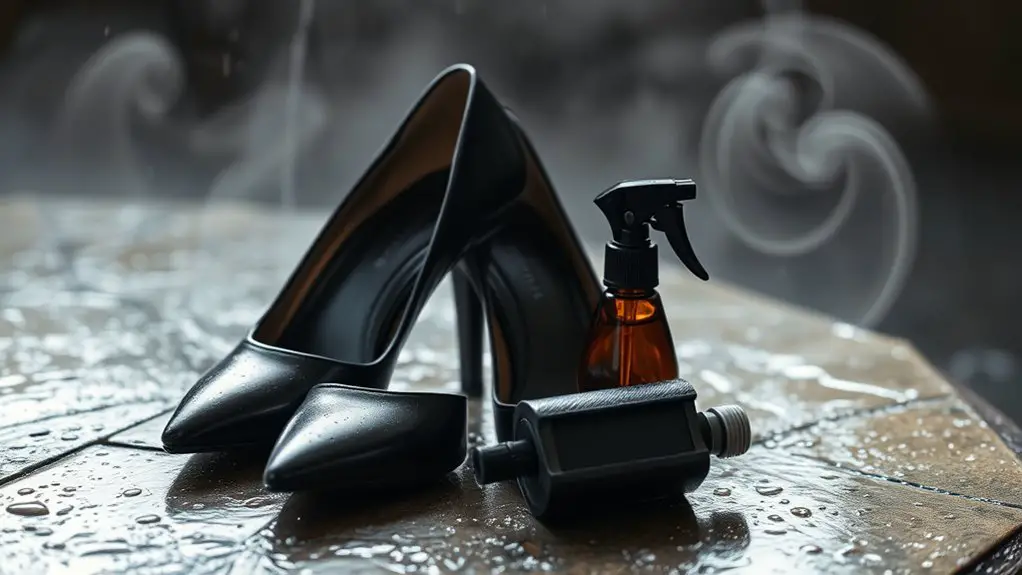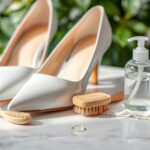To waterproof your heels for rainy days, start by choosing durable, water-repellent materials. Clean your heels thoroughly based on their material, using a soft cloth for leather or a suede brush for suede. After cleaning, apply a high-quality waterproofing spray evenly, keeping it 6-8 inches away. For extra protection, use warmed beeswax to create a moisture-resistant barrier. Finally, maintain your heels regularly and check the waterproofing as needed. There’s more helpful info to guarantee your heels stay protected!
Choose the Right Materials for Waterproofing
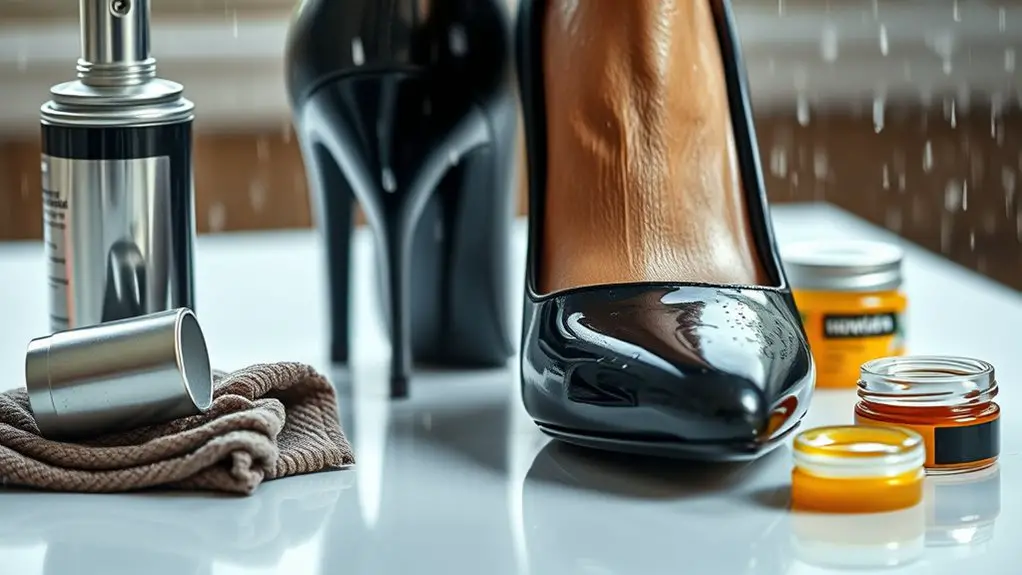
When it comes to waterproofing your heels, choosing the right materials is crucial for effective protection. You’ll want to look for materials that not only repel water but also offer material durability. Leather, for instance, can be treated with waterproofing sprays or creams, enhancing its natural resistance to moisture while maintaining its aesthetic appeal. Synthetic materials, like polyurethane, are often inherently waterproof and provide excellent durability against wear and tear.
Additionally, rubber soles are a game-changer; they offer superior grip and help prevent water from seeping in. When selecting waterproofing products, verify they’re designed specifically for the material of your heels. This will boost waterproofing effectiveness while preserving the finish. Always test a small area first to see how the material reacts. By making informed choices about materials and treatments, you’ll keep your heels looking great and protected from the elements.
Clean Your Heels Before Treatment
Before applying any waterproofing treatment, it’s essential to clean your heels thoroughly. Start by identifying the heel materials, whether they’re leather, suede, or synthetic. Each material requires specific cleaning tools. For leather, a soft cloth and a gentle leather cleaner work best. If your heels are made of suede, use a suede brush to lift dirt without damaging the fabric.
Remove any dirt or grime on the surface and pay special attention to crevices and seams where moisture can accumulate. If your heels have scuff marks, a specialized eraser can effectively eliminate them. After cleaning, let the heels dry completely—this step is vital because moisture can interfere with the waterproofing treatment.
Apply a Waterproofing Spray
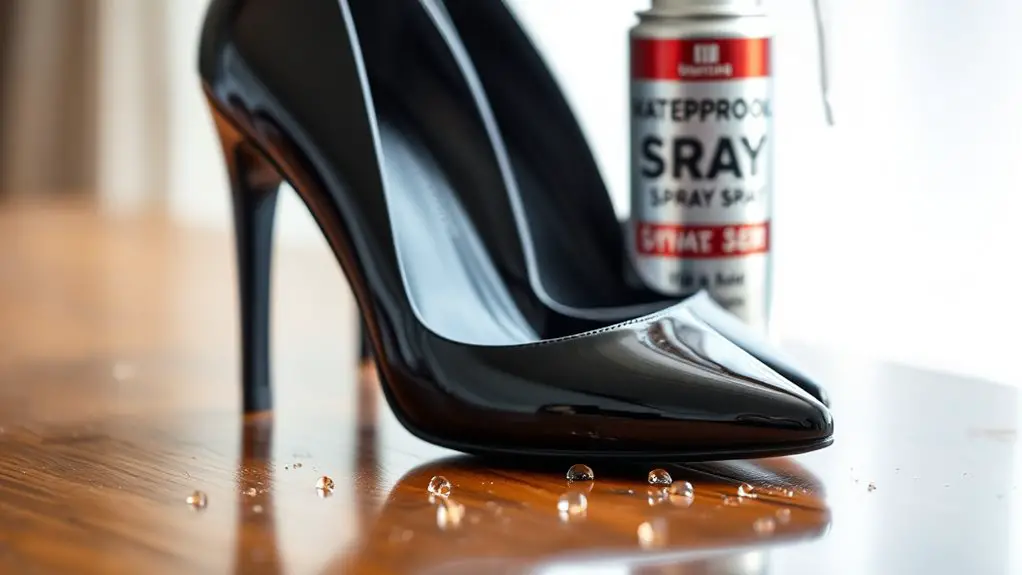
To effectively waterproof your heels, grab a high-quality waterproofing spray designed for the specific material of your shoes. Before you begin the spray application, make certain your heels are clean and dry to guarantee the best adhesion. Hold the spray about 6-8 inches away from the surface and apply an even coat, making sure to cover all areas, including seams and crevices, where water might seep in.
It’s wise to use waterproofing tips such as spraying in a well-ventilated area to avoid inhaling fumes. After the initial coat, let it dry for about 10-15 minutes before applying a second layer for added protection. Once you’re done, allow your heels to dry completely according to the manufacturer’s instructions. This process not only shields your shoes from rain but also helps maintain their appearance and longevity.
Use Beeswax for Extra Protection
Although many people rely on sprays for waterproofing, using beeswax can provide an extra layer of protection for your heels. Beeswax not only creates a water-resistant barrier but also nourishes leather, extending its lifespan. Here are some beeswax benefits and effective application techniques to contemplate:
- Natural and eco-friendly: Beeswax is a sustainable option that’s safe for you and the environment.
- Moisture retention: It helps keep leather hydrated, preventing cracks and dryness.
- Versatile: Works well on various types of leather, making it a great choice for different heels.
To apply, start by cleaning your heels and letting them dry completely. Warm the beeswax slightly to soften it, then rub it onto the leather in a circular motion. Don’t forget to focus on seams and creases! Let it sit for a few minutes, then buff with a soft cloth for a polished finish. Your heels will thank you!
Consider Waterproofing Solutions for Specific Materials
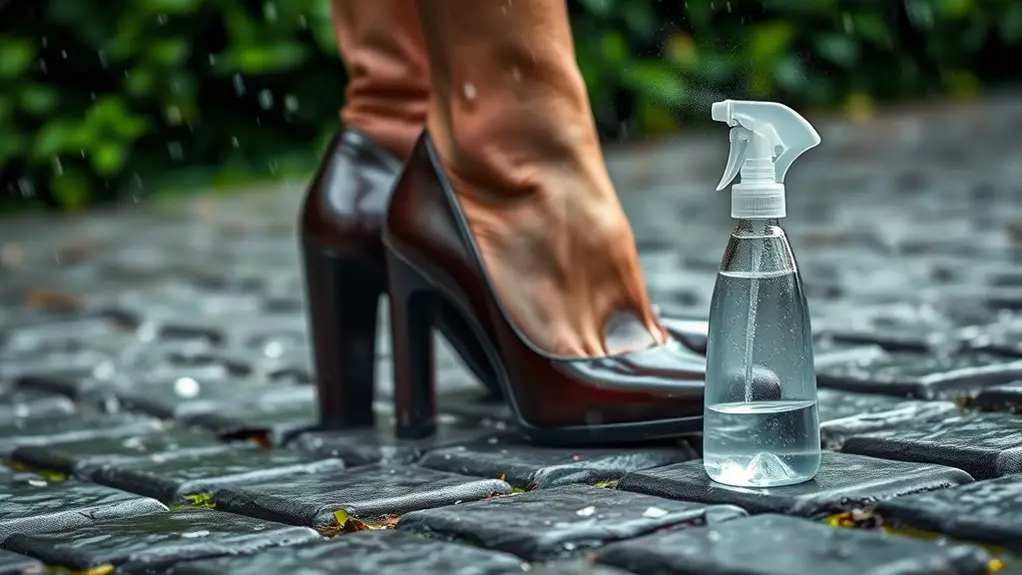
When it comes to waterproofing your heels, it’s essential to contemplate the specific materials your shoes are made from. Different treatments work best for leather, suede, and synthetic materials, so understanding these options can help you choose the right protection. By selecting the appropriate waterproofing solution, you can keep your heels looking great while extending their lifespan.
Leather Treatment Options
If you want to keep your leather heels looking pristine and protected from the elements, exploring the right treatment options is crucial. Here are some effective leather treatment strategies:
- Leather Conditioners: Not only do they nourish the leather, but they also provide crucial leather conditioners benefits, enhancing its flexibility and longevity.
- Waterproofing Sprays: These create a protective barrier against moisture while allowing the material to breathe, ensuring your heels stay dry.
- Leather Sealing Methods: Applying a sealant helps lock in moisture and protects against stains, making it a critical step in your waterproofing routine.
Suede Protectors Explained
Suede can be a beautiful addition to your heel collection, but it requires special care to maintain its appearance and durability. To protect your suede heels from moisture, consider applying a suede protector spray. These sprays create a barrier that enhances moisture resistance without altering the color or texture of the material. Before using any product, verify your heels are clean and dry; then, spray evenly from a distance, allowing them to dry completely. Regular application is key to effective suede care, particularly before rainy days. Additionally, avoid wearing suede in heavy rain, as excessive moisture can damage the fabric. With the right precautions, your suede heels can stay stylish and safeguarded against the elements.
Synthetic Material Solutions
While suede requires specialized care, synthetic materials offer a range of waterproofing options that can help protect your heels from the elements. With advancements in technology, you can easily enhance your synthetic heels’ durability. Here are some effective solutions:
- Synthetic Coatings: Apply a waterproof spray or treatment designed for synthetic materials, creating a protective layer against moisture.
- Water Repellent Fabrics: Consider heels made from water repellent fabrics that resist soaking and drying, keeping your feet dry and comfortable.
- Regular Maintenance: Clean and reapply treatments as needed to guarantee long-lasting protection.
Maintain Your Heels After Waterproofing
To keep your waterproof heels in top shape, you’ll want to establish a regular cleaning routine. This means gently wiping them down after each wear and using the appropriate cleaner for their material. Additionally, make it a habit to inspect your heels for any signs of damage, as early detection can save you from bigger repairs down the line.
Regular Cleaning Routine
Maintaining your heels after waterproofing is essential for prolonging their lifespan and keeping them looking pristine. Establishing a regular cleaning routine will help you achieve this. Here’s how often and what to use:
- Cleaning Frequency: Clean your heels every two weeks to remove dirt and grime.
- Preferred Products: Use a gentle leather cleaner for leather heels or a specialized suede cleaner for suede.
- Conditioning: Don’t forget to condition your heels after cleaning to maintain their texture and shine.
Inspect for Damage
After establishing a regular cleaning routine, it’s important to keep an eye out for any damage that may occur over time. Regular routine checks will help you catch issues before they worsen. Start by inspecting the heels for any visible wear, such as scuffs or scratches, which can compromise their waterproofing. Pay close attention to the seams and soles; small cracks can let moisture in. If you notice any damage, consider applying a specialized repair product or taking them to a professional cobbler. Don’t forget to check the waterproof coating periodically, as it may need reapplication. Keeping your heels in top condition not only extends their life but also guarantees you’re ready to face rainy days with confidence.
Frequently Asked Questions
Can I Waterproof Heels Made of Suede or Fabric?
You can’t fully waterproof suede or fabric, but using a suede care spray or fabric protection treatment helps repel water. Always test a small area first to guarantee it doesn’t affect the material’s appearance.
How Often Should I Reapply Waterproofing Treatments?
Oh sure, treat your heels like royalty! You should reapply waterproofing treatments every few months, depending on wear. Waterproofing frequency matters; keep an eye on treatment longevity to avoid soggy surprises when it rains.
Will Waterproofing Affect the Color of My Heels?
Waterproofing can affect the color of your heels, depending on the treatment used and the material compatibility. Always check for color preservation claims and test on a small area before applying to guarantee your heels remain vibrant.
Are There Any DIY Waterproofing Methods?
There’re several DIY waterproofing methods you can try, like using homemade solutions with beeswax or olive oil. These effective products can create a barrier, helping to protect your footwear from moisture and extending their lifespan.
Can I Use Waterproofing Sprays on Leather Handbags Too?
Yes, you can use waterproof sprays on leather handbags. Just make certain the spray is suitable for leather treatment. Apply it evenly, allowing it to dry completely, to protect your handbag from moisture while maintaining its appearance.

